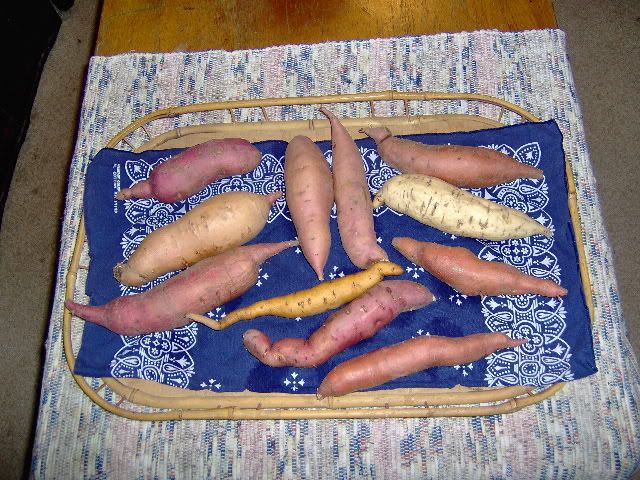
Varieties grown at Mapple Farm. The 2 vertical tubers at the top centre are Georgia Jet (left) and Tainung 65 (right). Below them are (top to bottom): Hannah, Japanese Yam and Beauregard. The three on the right are (top to bottom): Carver, Frazier White and Superior. The three on the left are (top to bottom): Regal, Ginseng Red and Excel.
I can’t remember where I first heard that there was such a thing as short season sweet potatoes, but I do remember that shortly after I was feverishly searching for somewhere to get the fabled variety Georgia Jet. I found it at Mapple Farms, in New Brunswick, along with various other short season varieties, chufa, Chinese artichokes, and unique seeds such as Wonderberry and Mystery Keeper Tomato. He also sells Ken Allan’s singular book Growing Sweet Potatoes for the Home Garden, with special techniques for northern growers.
***
When did you develop a love of edible plants?
I've always enjoyed eating and have a strong "nature boy" streak. I worked in many restaurant kitchens in my younger days. Once I finally had my own land to grow on, kitchen gardening developed into a passion.
You supply a number of difficult to source tubers like Chinese artichokes, chufa and short season sweet potatoes, along with a list of exciting seeds. What made you passionate about Sweet Potatoes?
Vegetable gardening became such an obsession, I knew I wanted to eventually make it part of my life's work. From the start, I wanted not to duplicate others' work but to offer something different. Back in the 1980s, when I first learned about the possibility of growing sweets in the north, I jumped at giving it a try. I knew that practically no one else was doing it. Once I found out how surprisingly well they did, there was no going back.
For a first time northern grower of sweet potatoes, what is the most crucial piece of advice for success?
Providing enough heat is the prime constraint. In borderline areas, methods that employ row covers (of, for example, slitted clear plastic or porous spun-bound polypropylene) or hoop house structures and/or plastic mulches that raise soil temps can make a difference.
Among your buyers, what was the coldest postal code that requested slips?
I've sent slips to Alaska, the Yukon and the Northwest Territories. I have an increasing number of growers who treat the slips as they would tomato plants (that is, they pot them up and then sometimes pot them on) for greater flexibility in choosing optimum transplanting conditions, increased yield, earlier maturity and/or success with longer season varieties.
It seems that you are always trying out new varieties of short season sweet potatoes, could you share some of their quirks, such as the fastest to bulk up, the tastiest, best for making certain dishes, or most interesting foliage?
Georgia Jet is by far my most popular variety. It does seem to be the most cold tolerant and the earliest to produce a crop. The one variety that occasionally out-yields it is Tainung 65, the longest vining type I've seen; it has striking bronze leaves and purple stems in low light (indoor) conditions. Superior sports attractive ivy-like foliage as does Ginseng Red but with even greater indentations. Japanese Yam and Carver have the most intense supporters by those after great flavor.
***
Mapple Farms Online Brochure

8 comments:
Thank goodness some suppliers thrive on being different. They carry a great variety of stuff.
Thx for another great interview and informative post.
I've always thought about growing sweet potatoes, but have been scared away by my climate. I wonder if even they would have survived the summer of 2009 in the northeast US. I just wish they would store for long periods of time like potatoes do. That might make them worth growing for me.
Daphne: Properly cured, they last longer than potatoes. I really, really recommend Ken Allan's book -short season varieties plus cultural methods equals a surprising amount of success. I used to think that it would be a waste of time to grow them here too. Do local CSAs grow them round your parts?
I'm not sure if the CSAs do or not. I don't see them at the farmer's markets though, and I go to three different ones.
Hi: just found your blog. I am going to try to start some veggies from seed this year. I noticed the seeds you have sent to a good home but it is not by the tigerella tomatoes. If you still have some I would love to trade for some heirloom yellow pear tomatoes. I live in Barrie, On. Thanks
Deb: Email me (look at my profile, right hand side). I'd be happy to send you some.
I don't see them often at farmer's markets either but the CSAs do carry them. We are zone 5a (US Zone 4) with 120days frost free days and average summer temperatures typically don't go over 25 degrees Celcius and it is generally easy here with soil warming techniques. I know they grow them in colder zones than me. Maybe'll you'll get a couple slips one of these days and let me know how they do. They make a pretty groundcover.
Dang!
Another seed seller I can't resist
Post a Comment